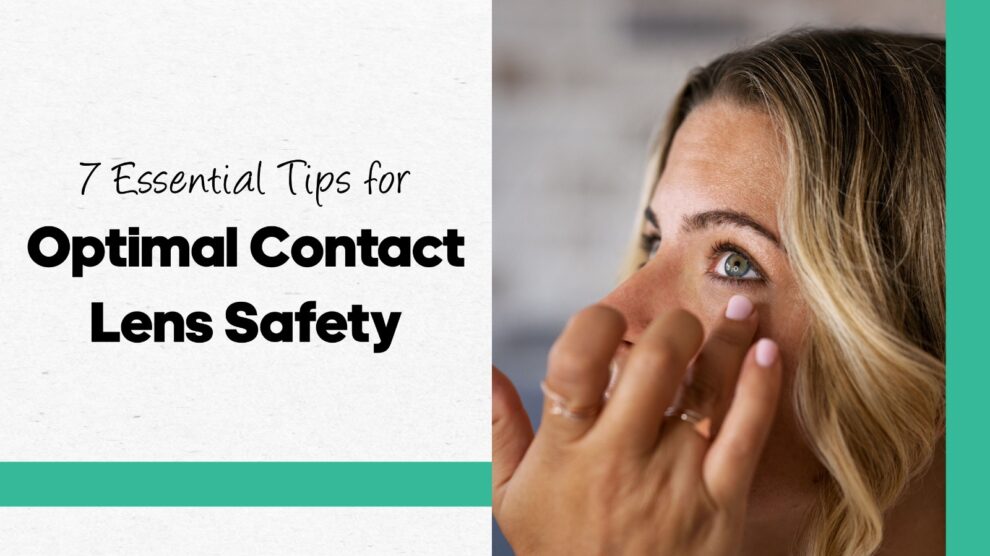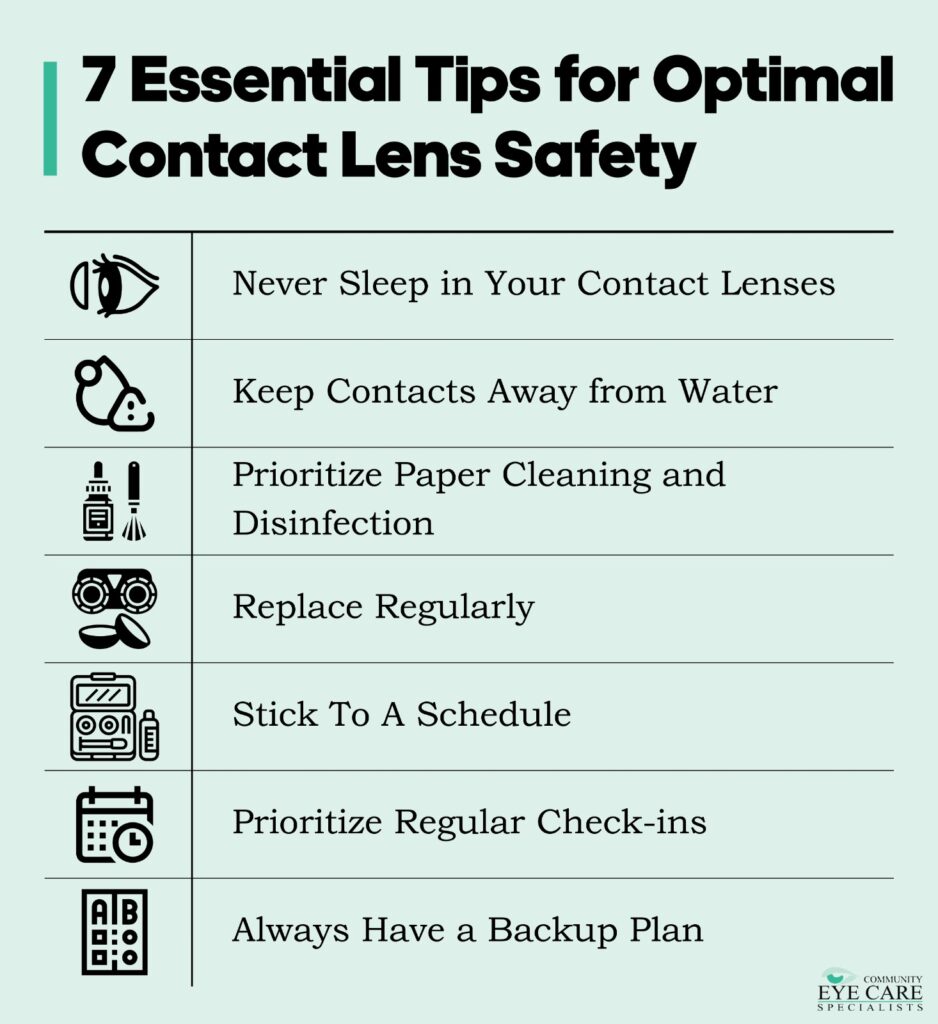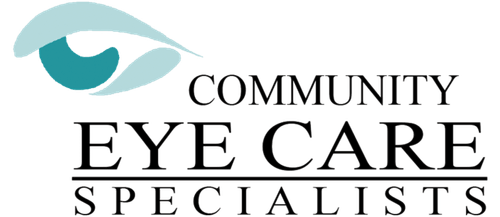Posted by: Community Eye Care Specialists in Contant Lens Safety

In today’s fast-paced world, many of us gravitate towards solutions that offer both convenience and functionality. Contact lenses undoubtedly fit that bill, merging the worlds of vision correction and aesthetics seamlessly. Their ability to correct refractive errors without the visible presence of eyeglasses has revolutionized how many of us perceive and address our visual needs. The freedom to engage in activities, unhindered by the weight or limitations of glasses, and the chance to flaunt our natural visage, are benefits that are hard to ignore.
However, with these advantages comes responsibility. The thin discs resting on the surface of our eyes might seem innocuous, but they require meticulous care. Why? Because even the slightest negligence can jeopardize our eye health, turning a boon into a potential bane. Ensuring the safety and hygiene of contact lens use isn’t just about maintaining the longevity of the lenses, but more importantly, it’s about protecting our precious eyesight.
As we delve into the nuances of contact lens safety in this article, let’s remember that with the right practices, we can enjoy the best of both worlds – impeccable vision without compromise and the aesthetic appeal that comes with lens use.

1. The Importance of Nightly Removal: Never Sleep in Your Contact Lenses
The convenience and clarity provided by contact lenses can be overshadowed by the risks that come with improper use. One of the most common mistakes contact lens wearers make is sleeping with their lenses on. While it may seem harmless to some, the consequences can be severe.
According to a study conducted by the Center for Disease Control (CDC), more than half of contact lens users admitted to having slept in their contact lenses at least once. Such a statistic is alarming, especially when considering the risks associated with this behavior. Sleeping in contact lenses can dramatically increase the risk of eye infections, some of which can have lasting consequences. The CDC further emphasizes that sleeping with contact lenses makes users up to eight times more susceptible to such infections.
The human eye, a marvel of biology, is designed to receive a significant amount of oxygen directly from the atmosphere. Contact lenses, especially when worn during sleep, can act as barriers, significantly reducing the amount of oxygen that reaches the cornea. When the oxygen supply is compromised, there’s an overgrowth of blood vessels in the eye, making them more susceptible to infections. Closed eyelids during sleep further reduce the oxygen supply and also trap potential germs on the lens surface close to the eye, compounding the risk.
But the threats don’t stop there. Apart from infections, sleeping in contact lenses can lead to other issues such as corneal ulcers, which can sometimes result in permanent vision loss. The lenses can also cause irritation, making the eyes red and uncomfortable.
The anatomy of the eye is intricately designed to function optimally under specific conditions. Disrupting its natural environment, especially by sleeping in contact lenses, can result in both short-term discomfort and long-term damage.
While contact lenses offer a clear and unobstructed view, their safe use requires responsibility. It’s crucial to remove them nightly to maintain eye health and prevent potential complications. The fleeting convenience of leaving them in overnight is simply not worth the potential hazards to one’s vision.
2. The Water Warning: Keeping Contacts Away from Water
Water, in its many forms, is an integral part of our daily lives. From the tap in our homes to the vast expanse of oceans and lakes, water is everywhere. However, when it comes to contact lens care, water poses a significant risk that wearers need to be aware of.
A common misconception among contact lens users is that clean water—whether from a tap or a purified bottle—is harmless for lenses. This belief could not be further from the truth. Every type of water, be it from rivers, oceans, lakes, swimming pools, hot tubs, or even distilled tap water, can be a breeding ground for harmful microorganisms. One such bacterium is acanthamoeba, which thrives in different water sources and can cause dangerous eye infections when it comes in contact with the eye via a lens.
When contact lenses are exposed to water, they can absorb these harmful microorganisms. Once on the lens, these pathogens are held in close proximity to the eye, making infections more likely. Such infections can not only be painful but can lead to long-term vision issues or even blindness in extreme cases.
To ensure eye safety, it’s crucial to adopt a few practices:
- Always remove contact lenses before swimming or taking a shower. If swimming is a regular activity, consider investing in prescription goggles.
- Never clean or store contact lenses in water. Instead, always use the recommended lens solution.
- Avoid washing your face with contacts in, or if necessary, close your eyes tightly to minimize water contact.
While water is essential for life, it can be a potential hazard for contact lens users. By being informed and adopting safe practices, you can enjoy the benefits of contact lenses without jeopardizing your eye health.
3. Prioritizing Proper Cleaning and Disinfection
The comfort and clarity that contact lenses offer can easily be compromised if not coupled with diligent cleaning and disinfection routines. Overlooking this vital step or resorting to shortcuts can escalate the chances of eye infections, as numerous articles on contact lens care have pointed out.
One of the biggest misconceptions is believing that any solution, especially saline, can disinfect contact lenses effectively. Saline, which is merely sterile salt water, cannot kill off harmful microorganisms. Using it as a disinfectant can therefore expose the eye to potentially harmful bacteria and fungi. This can lead to severe infections, as these pathogens, when stuck to contact lenses, can easily invade the eye and proliferate, causing considerable damage.
Another common mistake that has been reported is the act of “topping off” old solution in the contact lens case with a splash of new solution. This practice dilutes the disinfectant’s efficacy and turns the case into a breeding ground for germs. Each time you’re storing your lenses, it’s crucial to completely empty out the old solution and replace it with fresh disinfecting solution.
The timer on your contact lenses begins as soon as the package is open. For instance, if you have monthly lenses, they are meant to last from the first day of the month through the last, even if worn intermittently. As time progresses, the lens structure starts deteriorating, becoming a conducive environment for infection-causing bacteria. Using them beyond this period is risky.
To sum up, always ensure:
- Use only prescribed contact lens disinfecting solutions.
- Abstain from using saline or water for cleaning or storing lenses.
- Regularly replace solution in the case, avoiding the temptation to mix old and new.
Your eyes are precious. Treating your lenses with care ensures not just clear vision but also the health and safety of your eyes.
4. Case Care: The Significance of Regular Replacement
A factor often underestimated in the realm of contact lens hygiene is the very vessel that holds them: the contact lens case. Numerous sources, including the articles you provided, have accentuated the dangers of an ill-maintained contact lens case.
Eye infections are daunting, and the last thing you’d expect is your contact lens case, meant to protect and store your lenses, to be a contributor. Yet, just like a toothbrush or a kitchen sponge, contact lens cases are not exempt from collecting germs over time. They can, if not replaced periodically, become hotspots for microbial growth.
Risk comes with forgetting about the contact lens case. Your lens case, if not replaced every three months, ceases to be a sterile place to house your contacts. Over time, even with diligent cleaning, residue builds up. This residue can host bacteria that, when transferred to your lenses and subsequently to your eyes, can trigger infections or other ocular complications.
To ensure the longevity of your contact lenses and, more importantly, the health of your eyes:
- Always empty and rinse your contact lens case with fresh solution after placing your lenses in your eyes. Avoid rinsing with tap water.
- Leave the case open to air dry, ensuring it dries thoroughly.
- Ensure you replace your contact lens case at least every three months. Marking a reminder in your calendar can be a helpful way to remember.
To reiterate a point made earlier, the safety of your eyes should never be compromised. The minor investment in a new lens case every few months pales in comparison to the potential medical expenses and discomfort of an eye infection.
5. Stick to the Schedule: The Necessity of Replacing Lenses as Recommended
For many, the lure of extending the use of contact lenses beyond their recommended time can be tempting, especially if they still seem comfortable. However, as the articles shed light on, there’s a danger lurking behind this practice.
We emphasize that the timeline on your contact lenses starts ticking the moment the package is opened. Suppose you have monthly lenses. In that case, their durability stretches from the start of the month to its end, irrespective of whether you’ve worn them daily or just for a handful of days within that month. This isn’t a mere marketing strategy by contact lens manufacturers; it’s rooted in ensuring eye health.
Once contact lenses are past their recommended use period, they start to break down. Their structure becomes compromised, making them more susceptible to bacteria and less effective in providing comfort and clear vision. Think of it like food expiration dates – just because something looks or smells fine doesn’t mean it’s safe to consume.
To enhance this perspective, consider the analogy from one of the articles: You wouldn’t wear the same pair of socks for a month straight, would you? Just as socks accumulate dirt and sweat, contact lenses accumulate proteins, lipids, and potential pathogens over time.
To ensure your eyes remain safe and your vision unclouded:
- Always track the days you’ve been using a particular pair of lenses.
- Replace them diligently as per their type – daily, bi-weekly, or monthly.
- Remember, trying to economize by stretching their use can end up costing you more in medical bills and discomfort.
In the grander scheme of things, your vision and eye health are paramount. Don’t gamble them away for a few extra days of lens wear.
6. Regular Check-ins: Prioritize Regular Visits to Your Eye Care Provider
As touched upon in the articles, regular visits to your eye care provider are more than just a routine obligation. They serve as a crucial line of defense in maintaining optimal eye health, especially for those who wear contact lenses.
We here at Community Eye Care Specialists emphasize that keeping your prescription current is integral for both eye health and optimal vision. But why is this so important? Contact lenses are not just transparent discs; they’re medical devices specifically tailored to the unique contours and needs of each individual’s eyes. Over time, our eyes can undergo changes due to aging, health conditions, or even environmental factors. This is why ensuring that you’re wearing the right prescription is not just about clear vision.
Moreover, these regular check-ins with your eye care provider allow for a timely detection of any potential issues. Should there be any discomfort, pain, redness, or blurred vision, these appointments provide an opportunity to address them before they escalate. Remember, an ounce of prevention is worth a pound of cure.
Additionally, the fit of your contact lenses can also be evaluated during these visits. An ill-fitting lens can lead to discomfort and sub-optimal vision, as highlighted in the articles. Adjustments can be made based on the feedback you provide, ensuring that your lenses are as comfortable and effective as possible.
Think of these regular visits as a wellness check for your eyes. By being proactive and staying updated with your eye health, you not only guarantee the best vision but also safeguard your eyes against potential threats. Always prioritize your eye health and let the professionals at Community Eye Care Specialists guide you towards the best practices in contact lens safety.
7. Stay Prepared: Always Have a Backup Plan
Anyone who’s worn contact lenses knows that sometimes, the unexpected can happen. Maybe you’re on a weekend getaway and realize you’ve forgotten your contact lens solution, as described in one of the articles. Or perhaps you accidentally drop a lens, rendering it unusable. These situations can be more than just inconvenient; they can put your eyes at risk.
This is why we here at Community Eye Care Specialists emphasize the importance of always having a backup plan. One key element of that plan? Always keep a pair of glasses with your current prescription handy. Glasses can be a lifesaver in situations where it’s not feasible or safe to wear your contact lenses.
Being prepared isn’t just about having a fallback; it’s about ensuring the continuous care and protection of your eyes. Imagine if you couldn’t remove your contact lenses because you didn’t have access to solution or a case. Not only is this uncomfortable, but it can also lead to potential eye health issues if you’re forced to wear your lenses for prolonged periods.
Moreover, as highlighted in the articles, misusing or improperly storing contact lenses can lead to complications. These range from infections due to bacterial overgrowth in the case to the breakdown of the lens material itself.
In addition to glasses, consider packing a small emergency kit for your contacts. This could include a travel-sized bottle of solution, a spare lens case, and perhaps even a pair of daily disposable lenses.
While contact lenses offer unparalleled convenience and aesthetic benefits, it’s crucial to remember that they require consistent and proper care. Being prepared for unforeseen circumstances ensures that you maintain the highest standards of eye health, even when faced with unexpected challenges. At Community Eye Care Specialists, we always advocate for preparedness and safety-first when it comes to contact lens usage.
Prioritize Eye Health and Staying Informed
Contact lenses have revolutionized the way many individuals experience the world, providing clear vision without the constraints of glasses. Yet, with this privilege comes the responsibility of ensuring their proper and safe use. Each of the safety measures highlighted in this article is instrumental in maintaining not just the health of your eyes, but also the quality of your vision.
From avoiding the risks associated with sleeping in lenses to understanding the dangers of exposing them to water, and from ensuring regular visits to eye care professionals to being prepared for emergencies, every step is crucial. Missteps, however small they may seem, can have long-term ramifications.
Yet, the journey to eye health doesn’t have to be traveled alone. We here at Community Eye Care Specialists are committed to supporting you every step of the way. Our team is equipped with the knowledge, experience, and compassion to guide you in making the best decisions for your visual health.
If you have questions, concerns, or just need advice on any aspect of contact lens usage, please don’t hesitate to reach out to us. Remember, your eyes are not just windows to the world; they’re invaluable assets that deserve the best care possible. Let’s work together to ensure they remain healthy, safe, and seeing their very best.
We’re here to guide you on your journey towards better eye health. Click here to schedule an appointment with our caring and dedicated team today. Our mission is to provide excellent eye care and keep your world in clear focus.

